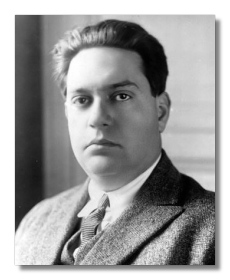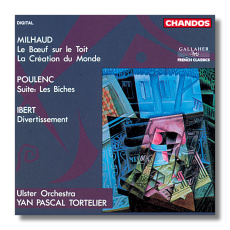
The Internet's Premier Classical Music Source
Related Links
-
Find CDs & Downloads
Amazon - UK - Germany - Canada - France - Japan
ArkivMusic - CD Universe
Find DVDs & Blu-ray
Amazon - UK - Germany - Canada - France - Japan
ArkivMusic-Video Universe
Find Scores & Sheet Music
Sheet Music Plus -
Recommended Links
Site News
Darius Milhaud

(1892 - 1974)
Born into an old Provençale Jewish family, Darius Milhaud (September 4, 1892 - June 22, 1974) became one of the most important French composers between the two world wars. A bookish boy, he was early influenced by the symbolists and the impressionists but soon became dissatisfied with them both. He did except Debussy from his disenchantment. The poet Francis Jammes became his first great literary enthusiasm. The family, comfortably well off, made no objection to young Darius's musical studies. He studied violin and in 1909 attended the Paris Conservatoire where he studied fugue with Widor and counterpoint, composition, and orchestration with André Gedalge, a great though under-recognized teacher whose pupils included Nadia Boulanger, Maurice Ravel, George Enesco, Arthur Honegger, Jacques Ibert, and Koechlin.
Paris furthered Milhaud's education in other ways as well. He came into contact with the musical avant-garde. Here he made the acquaintance of Mussorgsky's Boris Godunov (a score he venerated throughout his life) as well as the music of Gabriel Fauré, Ravel, Erik Satie, Ernest Bloch, Albéric Magnard, Albert Roussel, Igor Stravinsky, and even Arnold Schoenberg.
In 1912, Milhaud met the French Catholic poet Paul Claudel, and the two became friends. During World War I, Milhaud, rejected from combat on medical grounds, went to work for the propaganda department of the foreign ministry. Claudel, newly appointed minister to Brazil, took Milhaud along as his secretary. Claudel became perhaps Milhaud's main literary muse, providing libretti and ballet scenarios. Much of Milhaud's output show two often-simultaneous strains: a Mediterranean Jewish (specifically Provençale) sensibility, and a longing for universality, a cultural Catholicism.
After the war, Milhaud returned to Paris where he renewed old friendships and made new ones, most significantly with Erik Satie, whose aesthetic affected him. He became part of a group dubbed by Jean Cocteau "Les Six," which also included Francis Poulenc, Arthur Honegger, Georges Auric, Germaine Tailleferre, and Louis Durey. The group was more a Cocteau publicity stunt than an entity with common ideals. Significantly, they never all took part in any major project. They were basically friends, people who enjoyed each others' company. The most you could say for them as a group is that they were all influenced by Stravinsky. Milhaud also made several foreign tours: London, Vienna, the U.S., and the U.S.S.R. Each of these trips brought new musical revelations which Milhaud eagerly absorbed. Indeed, Milhaud was a musical omnivore, producing works based on Brazilian music (L'homme et son désir, 1918; Le boeuf sur le toit, 1919) and Harlem jazz (La création du monde, 1923, a year before George Gershwin's Rhapsody in Blue).
The music of the Twenties fell mainly under the aesthetic of Satie: spare, concise works, with popular sources prominent, and a penchant for sophisticated, circus hi-jinks. Milhaud experiments with form – radical rejections of 19th-century French aesthetics. He is particularly drawn to the direct statement and extreme concision: petite "symphonies" lasting no more than seven minutes; concerti over in the blink of an eye; the notorious opéras minutes. From the Teens, he had gone from an instinctual comprehension to a systematic study of what he called polytonality (music in different simultaneous keys) but which turned out in practice to be something closer to polymodality (think of major and minor scales played together). At the beginning, he uses this idiom mainly in the formation of harmonies, but as he goes along, the music unwinds to independent contrapuntal strands. Milhaud also comes up with creative uses for noise, especially percussion, beginning at least with L'homme et son désir and Les choéphores (1916) and culminating in the Percussion Concerto (1930). His experiments predate radicals like Edgard Varèse almost by a decade. The Thirties saw a concentration on film and stage and a new seriousness, as well as increasingly severe attacks of rheumatoid arthritis, which by the late Forties put him in a wheelchair.
Milhaud, as a progressive artist and a Jew, was undoubtedly on somebody's list and so fled to the United States after the fall of France to the Nazis in 1940. On the boat, he received a job offer from Mills College in Oakland, California, where he taught for over thirty years. After the war, he became a professor of composition at the Paris Conservatoire and thus split his time between the United States and Europe. The music of the Forties and especially of the war show an intense identification with France and Judaism in works like the Suite française (1944), Cantate de la guerre (1940), Borechou shema Israël (1944), Service sacré (1947), and Kaddisch (1945). The late Forties and onward produced music of greater experimentation and severity, with an emphasis on virtuoso counterpoint (the string quartets #14 and #15 of 1948 can be played separately or simultaneously as an octet), as well as works that one might categorize as remembrance, like Le château de feu (1954), Pacem in terris (1963), based on the encyclical by Pope John XXIII, and Ani maamin (1972, text by Elie Wiesel).
With Milhaud, as with Copland, one can divide his work into "easy" and "hard," although the easy, more often than not, shows just as much craft. La création du monde, for example, boasts a "jazz" fugue, not only fun, but a very good fugue. Kentuckiana (1948) bubbles like stewpot full of traditional mountain tunes, simultaneously jostling for attention. Furthermore, one finds a tremendous consistency of voice throughout a huge catalogue. Milhaud began producing characteristic work around 1912 and composed practically to his death. He could write very quickly and apparently in just about any circumstance – among chattering people, in a train, on the sidewalk of a city street, and so on. It would be odd if all of it were first-rate, but so much of it is indeed first-rate, even if not historically vital, like Rite of Spring.
Even so, the sheer bulk of his catalogue (at least 440 opus numbers) has worked against him. Few will make the effort to explore and sift. Furthermore, the dodecaphonists who rose to prominence after the war also painted him as a latter-day Vivaldi, continuing to write the same piece again and again. This is as spectacularly unfair to Vivaldi as it is to Milhaud. Though kept alive by early scores like La création, Suite provençale (1936), Saudades do Brasil (1921), Le cheminée du roi René (1939), and Scaramouche (1937), these survivors give only a small, distorted peek at his output and his stature. They emphasize his wit. However, he had a serious, almost Talmudic side to him as well. He produced masterpieces in every standard genre (and a few he made up himself).
I must say I don't know the chances of his long-term survival. On the other hand, he hasn't been given much of an opportunity so far to prove his art can survive. One has hope in his pupils. A teacher of genius, he taught such diverse figures as William Bolcom and Dave Brubeck, and they have played a large part in promoting his music after his death. Performers, especially those who play wind instruments (and thus have less repertoire to choose from than violinists, cellists, and pianists), occasionally bring out chamber-music gems in recital. Milhaud may yet come back, if not as a major voice, then as a substantial, poetic one. ~ Steve Schwartz

Recommended Recordings
La Création du Monde
- La Création du Monde, Op. 81; Le boeuf sur le toit with Poulenc & Ibert/Chandos CHAN9023
-
Yan Pascal Tortelier/Ulster Orchestra
- La Création du Monde; Le boeuf sur le toit, Suite provençale/Naxos 8.557287
-
Jean-Claude Casadesus/Lille National Orchestra
- La Création du Monde with Nelson, Summer, Balakrishnan, Price & Lennon/Telarc CD-80630
-
Turtle Island String Quartet, Ying String Quartet
Amazon - UK - Germany - Canada - France - Japan - ArkivMusic - CD Universe
Hybrid SACD 60630
Amazon - UK - Germany - Canada - France - Japan - ArkivMusic - CD Universe
- La Création du Monde, Op. 81 with Inghelbrecht, Poulenc & Ibert/Ess.a.y Recordings 1086
-
Richard Kapp/Philharmonia Virtuosi














